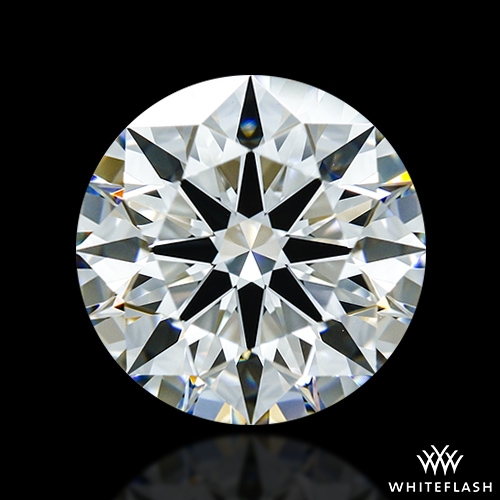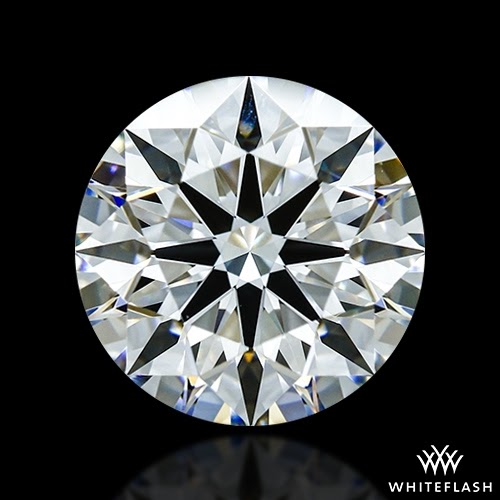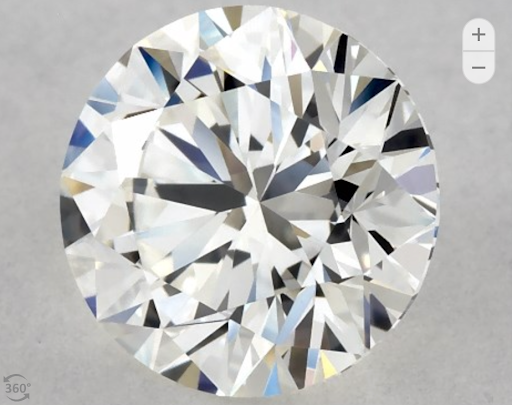This page contains references to diamonds or engagement rings from different companies. Sometimes I do receive a commission when you click on links and buy the products.
When you want a diamond with stunning quality, you can’t go wrong with a VVS1 clarity diamond.
But what are all these terms we’re throwing about? VVS1? Clarity? Terms like these can put of the inexperienced diamond buyer because they seem complicated. The truth is quite different, and learning what these terms mean can help make sure that when you’re buying a diamond, you’re getting your money’s worth.
Today, we’ll be covering everything you need to know about VVS1 diamonds.
- What Is a VVS1 Clarity Diamond?
- Why Choose a VVS1 Clarity Diamond?
- The Cost of a VVS1 Clarity Diamond
- Should you Buy a VVS1 Clarity Diamond?
- How to Choose a VVS1 Clarity Diamond
- VVS1 Clarity Diamonds: Our Recommendations
What Is a VVS1 Clarity Diamond?
A VVS1 grading for a diamond refers to a specific clarity that the diamond in question has. Clarity itself refers to the physical appearance of a diamond, how ‘clean’ it is internally. When diamonds are formed over millions of years, they can develop internal flaws known as blemishes and inclusions.
Don’t worry, these are completely natural and you’d be surprised at how many diamonds have them. They’re naturally occurring features and many are imperceptible to the human eye. Now, VVS1 is a grading that sits at the higher end of the clarity scale, meaning the diamond has a high quality clarity. This diamond clarity grading scale is determined by the Gemological Institute of America (GIA), which divides eleven grades into six categories, which you can see detailed in the chart below.

This diamond clarity chart is a little misleading, charts only show the location of inclusions NOT how bad they are. This is why you need a diamond guru to help.
VVS1 sits within the VVS category, one of the highest-rated on the entire scale. Diamonds are graded by undergoing a string of examinations, both under 10x magnification and by the eyes of skilled diamond experts. While darkfield lighting is used to reveal the diamond’s specific characteristics, strong overhead lighting helps the viewer to discover any inclusions that can either be found internally or on the surface of the stone.
VVS1 diamonds are eye-clean, which means any inclusions they may contain can’t be seen by the naked eye.
The Cost of A VVS1 Clarity Diamond
For a great example of a wide range of VS1 Clarity Diamonds and their relative prices, you can explore Whiteflash’s Round Cut Loose Diamonds, and use the in-built sliders to search for various ranges of VS1 diamond to discover what affects price the most. Click here to begin. I would also recommend trying James Allen as well.
Our best bit of advice when it comes to cost for a prospective diamond buyer? Always stay within a budget that is comfortable for you.
Should You Buy A VVS1 Clarity Diamond?
The overall answer to this question is complex—it’s an answer influenced by your taste, budget, and quality of research. But our short answer is this—why not buy a VVS1 diamond?
They’re some of the highest clarity-graded diamonds on the market today and also don’t carry the weighty pricetag of flawless diamonds. The most important factor when considering buying is finding a diamond that is eye-clean—like this one, for example.

A 1.037 ct F VVS1 A CUT ABOVE® Hearts and Arrows Diamond from Whiteflash
Eye clean is crucial for a stunning diamond. Fortunately, VVS1 diamonds will always be eye-clean due to their overall clarity grading. However, because of this, you might want to consider other features of your diamond as the overall deciding factor.
If a range of VVS1 diamonds you’re looking at are eye-clean, you might not know which one to choose. At this point, always choose cut as the influencing factor. Overall, cut is what dictates the light performance of a diamond over everything else.
How to Choose a VVS1 Clarity Diamond
We’ve spoken about clarity and cut—but what do they actually refer to and how should they influence what you buy?
Choosing a diamond is usually dictated by the Four Cs; Carat, Cut, Clarity, and Color. Now, as we’re talking VVS1 Clarity Diamonds, that C has already been decided. However, remember to weigh up the others:
Cut
When it comes to diamonds, cut is the most important factor for determining quality, as it actually has the most impact on the overall quality and the light performance of the diamond.
When cut, a diamond is essentially an item containing a number of tiny mirrors, each taking in and bouncing light in multiple directions. For the best light performance, a diamond should be cut with absolute precision, which makes for better light performance. The American Gem Society provides a grading scale for diamond cuts:
- 0 – Ideal
- 1 – Excellent
- 2 – Very Good
- 3, 4 – Good
- 5, 6, 7 – Fair
- 8, 9, 10 – Poor
You can find more information about diamond cut on our diamond cut education page.
Color
While, in general, the standard for an excellent diamond is colorless, color is really a subjective feature of a diamond. Many retailers and buyers want colorless, while others can be particularly interested in colored diamonds.
For example, if a diamond is colored with a very saturated yellow color, it’s known as either a ‘fancy yellow diamond’ or a ‘canary diamond’, which is quite popular in some circles.
If you’re looking for a colorless VVS1 Clarity Diamond, choose a diamond that sits within the colorless ‘D-F’ bracket.
Carat
For the uninitiated, carat represents the weight of the diamond. Usually, the higher the carat, the more expensive the diamond, as higher carat diamonds are rarer than their smaller counterparts.
One carat diamonds set the industry standard, being the most popular weight. With many retailers, you can search for diamonds through weight alone, with many offering their weighings within three decimal points.
However, like color, diamond carat is subjective.
Examples of Stunning VVS1 Diamonds
If you’re looking for top-quality diamonds, then Whiteflash’s A CUT ABOVE® range are some of the very best. Look at these examples to see why.
0.808 ct E VVS1 A CUT ABOVE® Hearts and Arrows Diamond
This VVS1 Clarity diamond sits at a fine 0.808 carat weight and has been AGS certified, meaning it is one of the best of the best. With an E color grade and an Ideal cut, this diamond is the perfect choice for anyone looking to choose something spectacular. Its cut has given it an intricate, charming, and complex light performance that you’ll rarely find in other diamonds.
Another option is this 1.01 carat round diamond H color vvs1 clarity which has Excellent proportions and a diamond grading report from GIA:
VVS1 Clarity Diamonds: Our Final Recommendations
VVS1 diamonds will always be the right investment for a piece of jewelry. They’re naturally eye-clean, and when crafted to Ideal cut parameters, provide the most brilliant dazzle. Plus, they look identical to Flawless diamonds, but cost far less.
If you want a truly stunning diamond, then a VVS1 might just be the diamond for you.

Richard Jenkins, The Diamond Guru
Get free assistance from the Diamond Guru today. You’ll be glad you did!
- Secure the best quality diamond for your budget.
- Don’t pay over the odds for your diamond ring.
- Have peace of mind that you didn’t get ripped off.
Have a Question? Contact us now…



